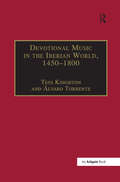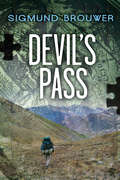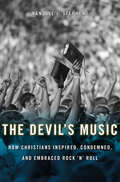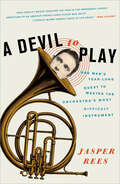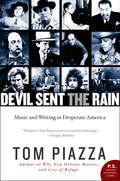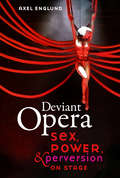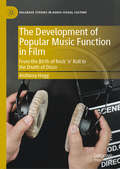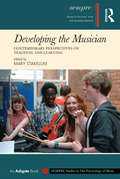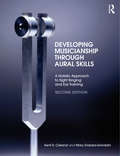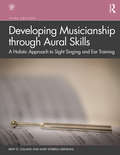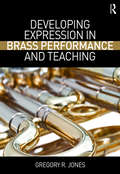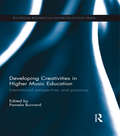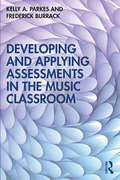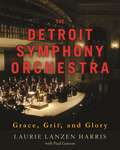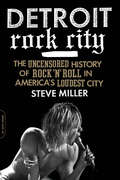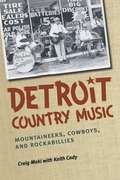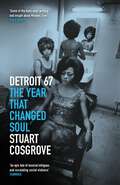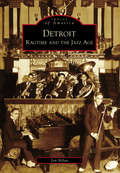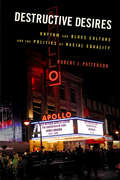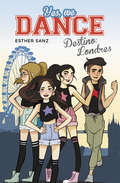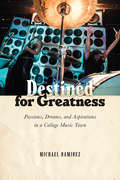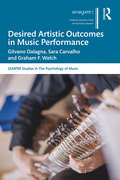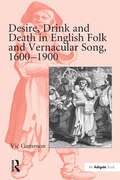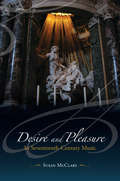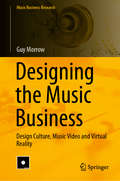- Table View
- List View
Devotional Music in the Iberian World, 1450-1800: The Villancico and Related Genres
by TESS KNIGHTON AND ÁLVARO TORRENTEFrom the fifteenth century to the beginning of the nineteenth century, devotional music played a fundamental role in the Iberian world. Songs in the vernacular, usually referred to by the generic name of 'villancico', but including forms as varied as madrigals, ensaladas, tonos, cantatas or even oratorios, were regularly performed at many religious feasts in major churches, royal and private chapels, convents and in monasteries. These compositions appear to have progressively fulfilled or supplemented the role occupied by the Latin motet in other countries and, as they were often composed anew for each celebration, the surviving sources vastly outnumber those of Latin compositions; they can be counted in tens of thousands. The close relationship with secular genres, both musical, literary and performative, turned these compositions into a major vehicle for dissemination of vernacular styles throughout the Iberian world. This model of musical production was also cultivated in Portugal and rapidly exported to the Spanish and Portuguese colonies in America and Asia. In many cases, the villancico repertory represents the oldest surviving source of music produced in these regions, thus affording it a primary role in the construction of national identities. The sixteen essays in this volume explore the development of devotional music in the Iberian world in this period, providing the first broad-based survey of this important genre.
Devil's Pass (Seven (the Series))
by Sigmund BrouwerSeventeen-year-old Webb's abusive stepfather has made it impossible for him to live at home, so Webb survives on the streets of Toronto by busking with his guitar and working as a dishwasher. When Webb's grandfather dies, his will stipulates that his grandsons fulfill specific requests. Webb's task takes him to the Canol Trail in Canada's Far North, where he finds out that there are much scarier things than the cold and the occasional grizzly bear. With a Native guide, two German tourists and his guitar for company, Webb is forced to confront terrible events in his grandfather's past and somehow deal with the pain and confusion of his own life.
The Devil’s Music: How Christians Inspired, Condemned, and Embraced Rock ’n’ Roll
by Randall J. StephensWhen rock ’n’ roll emerged in the 1950s, ministers denounced it from their pulpits and Sunday school teachers warned of the music’s demonic origins. The big beat, said Billy Graham, was “ever working in the world for evil.” Yet by the early 2000s Christian rock had become a billion-dollar industry. The Devil’s Music tells the story of this transformation. Rock’s origins lie in part with the energetic Southern Pentecostal churches where Elvis, Little Richard, James Brown, and other pioneers of the genre worshipped as children. Randall J. Stephens shows that the music, styles, and ideas of tongue-speaking churches powerfully influenced these early performers. As rock ’n’ roll’s popularity grew, white preachers tried to distance their flock from this “blasphemous jungle music,” with little success. By the 1960s, Christian leaders feared the Beatles really were more popular than Jesus, as John Lennon claimed. Stephens argues that in the early days of rock ’n’ roll, faith served as a vehicle for whites’ racial fears. A decade later, evangelical Christians were at odds with the counterculture and the antiwar movement. By associating the music of blacks and hippies with godlessness, believers used their faith to justify racism and conservative politics. But in a reversal of strategy in the early 1970s, the same evangelicals embraced Christian rock as a way to express Jesus’s message within their own religious community and project it into a secular world. In Stephens’s compelling narrative, the result was a powerful fusion of conservatism and popular culture whose effects are still felt today.
A Devil to Play: One Man's Year-Long Quest to Master the Orchestra's Most Difficult Instrument
by Jasper ReesIn the days before his fortieth birthday, London-based journalist Jasper Rees trades his pen for a French horn that has been gathering dust in the attic for more than twenty-two years, and, on a lark, plays it at the annual festival of the British Horn Society. Despite an embarrassingly poor performance, the experience inspires Rees to embark on a daunting, bizarre, and ultimately winning journey: to return to the festival in one year's time and play a Mozart concerto—solo—to a large paying audience.A Devil to Play is the true story of an unlikely midlife crisis spent conquering sixteen feet of wrapped brass tubing widely regarded as the most difficult instrument to master, as well as the most treacherous to play in public. It is the history of man's first musical instrument, a compelling journey that moves from the walls of Jericho to Sgt. Pepper's Lonely Hearts Club Band, from the hunting fields of France to the heart of Hollywood. And it is the account of one man's mounting musical obsession, told with pitch-perfect wit and an undeniable charm—an endearing, inspiring tale of perseverance and achievement, relayed masterfully, one side-splittingly off-key note at a time.
Devil Sent the Rain
by Tom PiazzaTom Piazza's sharp intelligence, insight, and passion fuel this new collection of writings on music, literature, New Orleans, and America itself in desperate times. For his first book since his award-winning novel City of Refuge and his stunning and influential post-Katrina polemic Why New Orleans Matters, Piazza selects the best of his writings on American roots music and musicians, including his Grammy-winning album notes for Martin Scorsese Presents: The Blues; his classic profile of bluegrass legend Jimmy Martin; essays on Jimmie Rodgers, Charley Patton, and Bob Dylan; and much more. In the book's second section, Piazza turns his attention to literature, politics, and post-Katrina America in articles and essays on subjects ranging from Charlie Chan movies to the life and work of Norman Mailer, from the New Orleans housing crisis to the BP oil spill, from Jelly Roll Morton's Library of Congress recordings to the future of books. The third and final section delivers a startlingly original meditation on fiction, sentimentality, and cynicism-a major new essay from this brilliant, unpredictable, and absolutely necessary writer.
Deviant Opera: Sex, Power, and Perversion on Stage
by Axel EnglundImagine Armida, Handel’s Saracen sorceress, performing her breakneck coloraturas in a black figure-hugging rubber dress, beating her insubordinate furies into submission with a cane, suspending a captive Rinaldo in chains from the ceiling of her dungeon. Mozart’s peasant girl Zerlina, meanwhile, is tying up and blindfolding her fiancé to seduce him out of his jealousy of Don Giovanni. And how about Wagner’s wizard, Klingsor, ensnaring his choir of flower maidens in elaborate Japanese rope bondage? Opera, it would appear, has developed a taste for sadomasochism. For decades now, radical stage directors have repeatedly dressed canonical operas—from Handel and Mozart to Wagner and Puccini, and beyond—in whips, chains, leather, and other regalia of SM and fetishism. Deviant Opera seeks to understand this phenomenon, approaching the contemporary visual code of perversion as a lens through which opera focuses and scrutinizes its own configurations of sex, gender, power, and violence. The emerging image is that of an art form that habitually plays with an eroticization of cruelty and humiliation, inviting its devotees to take sensual pleasure in the suffering of others. Ultimately, Deviant Opera argues that this species of opera fantasizes about breaking the boundaries of its own role-playing, and pushing its erotic power exchanges from the enacted to the actual.
The Development of Popular Music Function in Film: From the Birth of Rock ‘n’ Roll to the Death of Disco (Palgrave Studies in Audio-Visual Culture)
by Anthony HoggThis book offers a unique examination of the development of popular music function in film. It assesses the contribution of popular music to the interpretation of the most significant films, covering the period from rock ‘n’ roll’s initial introduction at the opening of Blackboard Jungle, to the backlash against disco, which followed soon after the release of Saturday Night Fever. By dividing this period into five phases—The Classical American Musical Phase, The British Invasion Phase, The New Hollywood Alienation Phase, The Disco Phase and The Post-Disco Conservative Phase—the book pinpoints key moments at which individual developments occurred and lays out a path of expansion in popular music function. Each chapter offers close analyses of this period’s most innovative films; examines the cultural, historical, technical and industrial factors peculiar to each phase and considers the influence of these upon the specific timing of functional advances.
Developing the Musician: Contemporary Perspectives on Teaching and Learning (SEMPRE Studies in The Psychology of Music)
by Mary StakelumTo what extent does research on musical development impact on educational practices in school and the community? Do musicians from classical and popular traditions develop their identities in different ways? What do teachers and learners take into consideration when assessing progress? This book takes a fresh look at 'the musician' and what constitutes 'development' within the fields of music psychology and music education. In doing so, it explores the relationship between formative experiences and the development of the musician in a range of music education settings. It includes the perspectives of classroom teachers, popular musicians, classical musicians and music educators in higher education. Drawn from an international community of experienced educators and researchers, the contributors offer a range of approaches to research. From life history through classroom observation to content analysis, each section offers competing and complementary perspectives on contemporary practice. The book is an essential resource for musicians, educators, researchers and policy makers, offering insight into the reality of practice from those working within established traditions - such as the conservatoire and school settings - and from those who are currently emerging as significant forces in the fields of popular music education and community music.
Developing Musicianship Through Aural Skills: A Holistic Approach to Sight Singing and Ear Training
by Kent D. Cleland Mary Dobrea-GrindahlDeveloping Musicianship through Aural Skills, Second Edition, is a comprehensive method for learning to hear, sing, understand, and use the foundations of music as part of an integrated curriculum, incorporating both sight singing and ear training in one volume. Under the umbrella of musicianship, this textbook guides students to "hear what they see, and see what they hear," with a trained, discerning ear on both a musical and an aesthetic level. Key features of this new edition include: Revised organization, with exercises gradually progressing from the simple to more difficult, taking beginner students’ varied skill sets into account. An enhanced companion website, with interactive training modules for students to practice core skills, and additional exercises, dictation lesson plans and worksheets for instructors Enhanced coverage and a specific methodology for covering post-tonal material Greater emphasis on developing improvisation skills and realizing lead sheets The text reinforces both musicianship and theory in a systematic method, and its holistic approach provides students the skills necessary to incorporate professionalism, creativity, confidence, and performance preparation in their music education. The second edition of Developing Musicianship through Aural Skills provides a strong foundation for undergraduate music students and answers the need for combining skills in a more holistic, integrated music theory core.
Developing Musicianship through Aural Skills: A Holistic Approach to Sight Singing and Ear Training
by Kent D. Cleland Mary Dobrea-GrindahlDeveloping Musicianship through Aural Skills, Third Edition, is a comprehensive method for learning to hear, sing, understand, and use the foundations of music as part of an integrated curriculum, incorporating both sight singing and ear training in one volume. Under the umbrella of musicianship, this textbook guides students to "hear what they see, and see what they hear," with a trained, discerning ear on both a musical and an aesthetic level. Key features of this new edition include: Revised selection of musical examples, with added new examples including more excerpts from the literature, more part music, and examples at a wider range of levels, from easy to challenging New instructional material on dictation, phrase structure, hearing cadences, and reading lead sheets and Nashville number charts An updated website that now includes a comprehensive Teacher’s Guide with sample lesson plans, supplemental assignments, and test banks; instructional videos; and enhanced dictation exercises The text reinforces both musicianship and theory in a systematic method, and its holistic approach provides students the skills necessary to incorporate professionalism, creativity, confidence, and performance preparation in their music education. Over 1,600 musical examples represent a wide range of musical styles and genres, including classical, jazz, musical theatre, popular, and folk music. The third edition of Developing Musicianship through Aural Skills provides a strong foundation for undergraduate music students and answers the need for combining skills in a more holistic, integrated music theory core.
Developing Expression in Brass Performance and Teaching
by Gregory R. JonesDeveloping Expression in Brass Performance and Teaching helps university music teachers, high school band directors, private teachers, and students develop a vibrant and flexible approach to brass teaching and performance that keeps musical expression central to the learning process. Strategies for teaching both group and applied lessons will help instructors develop more expressive use of articulation, flexibility in sound production, and how to play with better intonation. The author shares strategies from today’s best brass instrument performers and teachers for developing creativity and making musical expression central to practicing and performing. These concepts presented are taken from over thirty years of experience with musicians like Wynton Marsalis, Barbara Butler, Charles Geyer, Donald Hunsberger, Leonard Candelaria, John Haynie, Bryan Goff, members of the Chicago Symphony and New York Philharmonic and from leading music schools such as the Eastman School of Music, The University of North Texas and The Florida State University.? The combination of philosophy, pedagogy, and common sense methods for learning will ignite both musicians and budding musicians to inspired teaching and playing.
Developing Creativities in Higher Music Education: International Perspectives and Practices (Routledge Research in Higher Education)
by Pamela BurnardThis is the first book to critically address the issue of how we can enhance and develop creativities in higher music education. It features new international, richly diverse perspectives on the nature and practice of creativities in different cultural and institutional contexts, in varying roles and in response to diverse professional pressures and expectations of artistic and educational achievement. This compelling and provocative book combines powerful social and educational commentaries and examples drawn from international sources based on original practices and experience of a diversity of creativities. The authors provide an important contribution by drawing attention to what is at the heart of all music and how we can understand and foster these multiple creativities at an individual and institutional level. It features new analyses of the question of creativities in higher music education, and offers illustrative and innovative examples of adaptive learning environments for teaching and learning creatively, considering the broader issue of the role of creativities in relation to educational policy in the context of increasingly interventionist governments and rapidly paced educational change. Topics covered include: -the conceptual tools for people to think about and debate multiple creativities -the role of creativities in higher music education-how musicians can develop multiple creativities in new ways -new approaches to teaching and learning for multiple creativities -what constitute leadership creativities in conservatoires and music departments-creativities at the interface of institutional learning cultures-assessing the multiple creativities of music. Developing Creativities in Higher Music Education offers a multi-disciplinary research and practice focus, which will be essential reading for anyone involved in higher education and industry sectors. The book will appeal to academics and practitioners in music, researchers, instrumental and vocal teachers, curriculum and policy developers and institutional managers who want to enrich the higher education experiences of their students and enable them to develop more of their creative potential. It is also ideal reading for undergraduate and postgraduate students of music education who are looking for an authoritative selection of writings that define the fields of musical creativities in one comprehensive volume.
Developing and Applying Assessments in the Music Classroom
by Kelly A. Parkes Frederick BurrackDeveloping and Applying Assessments in the Music Classroom addresses the challenges faced by today’s K-12 educators and future music educators who are expected to utilize and incorporate assessment data as a hallmark of student learning and reflection of effective teaching. Highlighting best practices while presenting current scholarship and literature, this practical workbook-style text provides future music teachers with a framework for integrating assessment processes in the face of a certain lack of understanding and possible dissatisfaction with assessment tools and tasks. Each chapter is prefaced by an overview outlining learning expectations and essential questions, and supplemented throughout by an array of pedagogical features: Discussion prompts Activities and worksheets Learning experiences Expanded reference lists Citing examples across a range of musical settings—e.g. band, chorus, orchestra, jazz, and piano and guitar labs—Developing and Applying Assessments in the Music Classroom builds from the classroom assessment paradigm, encouraging teachers to create assessment tasks most appropriate to their curricula goals and planned student outcomes. Joined by fellow experts in the field Brian C. Wesolowski and Phillip Payne, the authors invite readers to explore and apply the material in authentic ways to inspire student learning through a comprehensive approach to educative assessment.
The Detroit Symphony Orchestra: Grace, Grit, and Glory (Painted Turtle)
by Laurie Lanzen Harris Paul GansonThe Detroit Symphony Orchestra: Grace, Grit, and Glory details the history of the Detroit Symphony Orchestra as seen through the prism of the city it has called home for nearly 130 years. Now one of America’s finest orchestras, the Detroit Symphony Orchestra began in 1887 as a rather small ensemble of around thirty-five players in a city that was just emerging as an industrial powerhouse. Since then, both the city and its orchestra have known great success in musical artistry for the symphony and economic influence for the city. They have each faced crises as well—financial, social, and cultural—that have forced the DSO into closure three times, and the city to the brink of dissolution. Yet somehow, in the face of adversity, the DSO stands strong today, a beacon of perseverance and rebirth in a city of second chances. This is the first history of the DSO to document the orchestra from its earliest incarnation in the late nineteenth century to its current status as one of the top orchestras in the country. The Detroit Symphony Orchestra tells the story of the organization—the musicians, the musical directors, the boards, and the management—as they strove for musical excellence, and the consistent funding and leadership to achieve it in the changing economic and cultural landscape of Detroit. Author Laurie Lanzen Harris, with Paul Ganson, explores the cycles of glory, collapse, and renewal of the orchestra in light of the city’s own dynamic economic, demographic, and cultural changes. Any reader with an interest in Detroit history or the history of American symphony orchestras should have this book on his or her shelf.
Detroit Rock City: The Uncensored History of Rock 'n' Roll in America's Loudest City
by Steve MillerDetroit Rock City is an oral history of Detroit and its music told by the people who were on the stage, in the clubs, the practice rooms, studios, and in the audience, blasting the music out and soaking it up, in every scene from 1967 to today.From fabled axe men like Ted Nugent, Dick Wagner, and James Williamson jump to Jack White, to pop flashes Suzi Quatro and Andrew W.K., to proto punkers Brother Wayne Kramer and Iggy Pop, Detroit slices the rest of the land with way more than its share of the Rock Pie.Detroit Rock City is the story that has never before been sprung, a frenzied and schooled account of both past and present, calling in the halcyon days of the Grande Ballroom and the Eastown Theater, where national acts who came thru were made to stand and deliver in the face of the always hard hitting local support acts. It moves on to the Michigan Palace, Bookies Club 870, City Club, Gold Dollar, and Magic Stick - all magical venues in America's top rock city.Detroit Rock City brings these worlds to life all from the guys and dolls who picked up a Strat and jammed it into our collective craniums. From those behind the scenes cats who promoted, cajoled, lost their shirts, and popped the platters to the punters who drove from everywhere, this is the book that gives life to Detroit's legend of loud.
Detroit Country Music: Mountaineers, Cowboys, And Rockabillies
by Craig Maki Keith CadyThe richness of Detroit’s music history has by now been well established. We know all about Motown, the MC5, and Iggy and the Stooges. We also know about the important part the Motor City has played in the history of jazz. But there are stories about the music of Detroit that remain untold. One of the lesser known but nonetheless fascinating histories is contained within Detroit’s country music roots. At last, Craig Maki and Keith Cady bring to light Detroit’s most important country and western and bluegrass stars, such as Chief Redbird, the York Brothers, and Roy Hall. Beyond the individuals, Maki and Cady also map out the labels, radio programs, and performance venues that sustained Detroit’s vibrant country and bluegrass music scene. In the process, Detroit Country Music examines how and why the city’s growth in the early twentieth century, particularly the southern migration tied to the auto industry, led to this vibrant roots music scene. This is the first book—the first resource of any kind—to tell the story of Detroit’s contributions to country music. Craig Maki and Keith Cady have spent two decades collecting music and images, and visiting veteran musicians to amass more than seventy interviews about country music in Detroit. Just as astounding as the book’s revelations are the photographs, most of which have never been published before. Detroit Country Music will be essential reading for music historians, record collectors, roots music fans, and Detroit music aficionados.
Detroit 67: The Year That Changed Soul (The Soul Trilogy #1)
by Stuart CosgroveFirst in the award-winning soul music trilogy—featuring Motown artists Diana Ross & the Supremes, Smokey Robinson, Marvin Gaye, and others. Detroit 67 is &“a dramatic account of twelve remarkable months in the Motor City&” during the year that changed everything (Sunday Mail). It takes you on a turbulent journey through the drama and chaos that ripped through the city in 1967 and tore it apart in personal, political, and interracial disputes. It is the story of Motown, the breakup of the Supremes, and the damaging clashes at the heart of the most successful African American music label ever. Set against a backdrop of urban riots, escalating war in Vietnam, and police corruption, the book weaves its way through a year when soul music came of age and the underground counterculture flourished. LSD arrived in the city with hallucinogenic power, and local guitar band MC5—self-styled holy barbarians of rock—went to war with mainstream America. A summer of street-level rebellion turned Detroit into one of the most notorious cities on earth, known for its unique creativity, its unpredictability, and self-lacerating crime rates. The year 1967 ended in social meltdown, rancor, and intense legal warfare as the complex threads that held Detroit together finally unraveled. &“A whole-hearted evocation of people and places,&” Detroit 67 is &“a tale set at a fulcrum of American social and cultural history&” (Independent).
Detroit: Ragtime and the Jazz Age
by Jon MilanDetroit has always been at the forefront of American popular music development, and the ragtime years and jazz age are no exception. The city's long history of diversity has served the region well, providing a fertile environment for creating and nurturing some of America's most distinctly indigenous music. With a focus on the people and places that made Detroit a major contributor to America's rich musical heritage, Detroit: Ragtime and the Jazz Age provides a unique photo journal of a period stretching from the Civil War to the diminishing years of the big bands in the early 1940s.
Destructive Desires: Rhythm and Blues Culture and the Politics of Racial Equality
by Robert J. PattersonDespite rhythm and blues culture’s undeniable role in molding, reflecting, and reshaping black cultural production, consciousness, and politics, it has yet to receive the serious scholarly examination it deserves. Destructive Desires corrects this omission by analyzing how post-Civil Rights era rhythm and blues culture articulates competing and conflicting political, social, familial, and economic desires within and for African American communities. As an important form of black cultural production, rhythm and blues music helps us to understand black political and cultural desires and longings in light of neo-liberalism’s increased codification in America’s racial politics and policies since the 1970s. Robert J. Patterson provides a thorough analysis of four artists—Kenneth “Babyface” Edmonds, Adina Howard, Whitney Houston, and Toni Braxton—to examine black cultural longings by demonstrating how our reading of specific moments in their lives, careers, and performances serve as metacommentaries for broader issues in black culture and politics.
Destino: Londres (Serie Yes, we dance #Volumen 2)
by Esther Sanz¡Acompaña a Martina, Sofía, Liu y Violeta en esta nueva aventura en el corazón de Londres! Martina y sus amigas viajan hasta la capital inglesa para participar en el maratón de baile que va a celebrarse en el Hyde Park. El grupo que salga ganador de esta competición será el que aparecerá en el nuevo videoclip del grupo del momento, los BB Brothers. No será nada fácil, pero las chicas lo tienen claro... ¡Están dispuestas a darlo todo!
Destined for Greatness: Passions, Dreams, and Aspirations in a College Music Town
by Michael RamirezPursuing the dream of a musical vocation—particularly in rock music—is typically regarded as an adolescent pipedream. Music is marked as an appropriate leisure activity, but one that should be discarded upon entering adulthood. How then do many men and women aspire to forge careers in music upon entering adulthood? In Destined for Greatness, sociologist Michael Ramirez examines the lives of forty-eight independent rock musicians who seek out such non-normative choices in a college town renowned for its music scene. He explores the rich life course trajectories of women and men to explore the extent to which pathways are structured to allow some, but not all, individuals to fashion careers in music worlds. Ramirez suggests a more nuanced understanding of factors that enable the pursuit of musical livelihoods well into adulthood.
Desired Artistic Outcomes in Music Performance (SEMPRE Studies in The Psychology of Music)
by Gilvano Dalagna Sara Carvalho Graham F. WelchDesired Artistic Outcomes in Music Performance is about empowering musicians to achieve their professional and personal goals in music. The narrative argues that developing musicians should be supported in conceptualizing and achieving their desired artistic outcomes (DAO), as these have been recognized as key elements in a successful career transition in and beyond their studies in higher education. The text explores the nature of DAO and illustrates how higher education students can be enabled to explore and develop these. The book draws on the findings from a range of exploratory studies which: Bring to light connections between contemporary topics in music, such as artistic research and career development; Contribute to existing discussions on innovative pedagogical approaches in higher education in music; and Offer theoretical models to support the broad artistic and professional development in young musicians. This is a text grounded in theory and practice, and which draws on case study examples, as well as historical perspectives and coverage of contemporary issues regarding employment in the music industries. The book will be of particular interest to aspiring music professionals and all those working in the areas of Music Education, Performance Studies and Artistic Research.
Desire, Drink and Death in English Folk and Vernacular Song, 1600-1900
by Vic GammonThis much-needed book provides valuable insights into themes and genres in popular song in the period c. 1600-1900. In particular it is a study of popular ballads as they appeared on printed sheets and as they were recorded by folk song collectors. Vic Gammon displays his interest in the way song articulates aspects of popular mentality and he relates the discourse of the songs to social history. Gammon discusses the themes and narratives that run through genres of song material and how these are repeated and reworked through time. He argues that in spite of important social and economic changes, the period 1600-1850 had a significant cultural consistency and characteristic forms of popular musical and cultural expression. These only changed radically under the impact of industrialization and urbanization in the nineteenth century. The book will appeal to those interested in folk song, historical popular music (including church music), ballad literature, popular literature, popular culture, social history, anthropology and sociology.
Desire and Pleasure in Seventeenth-Century Music
by Susan McclaryIn this book, Susan McClary examines the mechanisms through which seventeenth-century musicians simulated extreme affective states--desire, divine rapture, and ecstatic pleasure. She demonstrates how every major genre of the period, from opera to religious music to instrumental pieces based on dances, was part of this striving for heightened passions by performers and listeners. While she analyzes the social and historical reasons for the high value placed on expressive intensity in both secular and sacred music, and she also links desire and pleasure to the many technical innovations of the period. McClary shows how musicians--whether working within the contexts of the Reformation or Counter-Reformation, Absolutists courts or commercial enterprises in Venice--were able to manipulate known procedures to produce radically new ways of experiencing time and the Self.
Designing the Music Business: Design Culture, Music Video and Virtual Reality (Music Business Research)
by Guy MorrowThis book addresses the neglect of visual creativities and content, and how these are commercialised in the music industries. While musical and visual creativities drive growth, there is a lack of literature relating to the visual side of the music business, which is significant given that the production of meaning and value within this business occurs across a number of textual sites.Popular music is a multimedia, discursive, fluid, and expansive cultural form that, in addition to the music itself, includes album covers; gig and tour posters; music videos; set, stage, and lighting designs; live concert footage; websites; virtual reality/augmented reality technologies; merchandise designs; and other forms of visual content. As a result, it has become impossible to understand the meaning and value of music without considering its relation to these visual components and to the interrelationships between them. Using design culture theory, participant observation, interviews, case studies, and a visual methodology to explore the topic, this research-based book is a valuable study aid for undergraduate and postgraduate students of subjects including the music business, design, arts management, creative and cultural industries studies, business and management studies, and media and communications.
